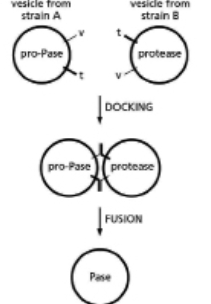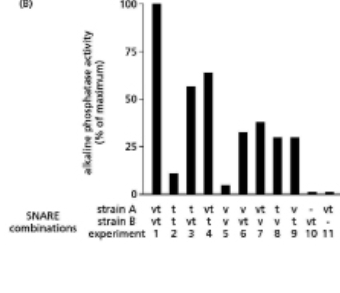v-SNAREs and t-SNAREs mediate the recognition of a vesicle at its target membrane so that a vesicle displaying a particular type of v-SNARE will only fuse with a target membrane containing a complementary type of t-SNARE.In some cases, v-SNAREs and t-SNAREs may also mediate the fusion of identical membranes.In yeast cells, right before the formation of a new cell, vesicles derived from the vacuole will come together and fuse to form a new vacuole destined for the new cell.Unlike the situation we have discussed in class, the vacuolar vesicles contain both v-SNAREs and t-SNAREs.Your friend is trying to understand the role of these SNAREs in the formation of the new vacuole and consults with you regarding the interpretation of his data.
Your friend has designed an ingenious assay for the fusion of vacuolar vesicles by using alkaline phosphatase.The protein alkaline phosphatase is made in a "pro" form that must be cleaved for the protein to be active.Your friend has designed two different strains of yeast: strain A produces the "pro" form of alkaline phosphatase (pro-Pase), whereas strain B produces the protease that can cleave pro-Pase into the active form (Pase).Neither strain has the active form of the alkaline phosphatase, but when vacuolar vesicles from the strains A and B are mixed, fusion of vesicles generates active alkaline phosphatase, whose activity can be measured and quantified (Figure 15-9A). (A)

Figure 15-9
Your friend has taken each of these yeast strains and further engineered them so that they express only the v-SNAREs, only the t-SNAREs, both SNAREs (the normal situation), or neither SNARE.He then isolates vacuolar vesicles from all strains and tests the ability of each variant form of strain A to fuse with each variant form of strain B, by using the alkaline phosphatase assay.The data are shown in the graph in Figure 15-9B.On this graph, the SNARE present on the vesicle of the particular yeast strain is indicated as "v" (for the presence of the v-SNARE) and "t" (for the presence of the t-SNARE).
What do his data say about the requirements for v-SNAREs and t-SNAREs in the vacuolar vesicles? Is it important to have a specific type of SNARE (that is, v-SNARE or t-SNARE) on each vesicle?
Definitions:
Double-entry Accounting
An accounting method where every financial transaction results in equal and opposite effects in at least two different accounts.
Ledger
A book or collection of financial accounts where all transaction records are summarized and recorded.
Journal
A book or digital record where all financial transactions are initially recorded in chronological order before being posted to accounts in the ledger.
Debit
A bookkeeping record that leads to either a rise in assets or a fall in liabilities in a firm's balance sheet.
Q2: According to the raise or waive doctrine,a
Q4: While many prokaryotic cells have a single
Q5: Which of the following statements about what
Q13: The conversion of fructose 1,6-bisphosphate to fructose
Q16: Which of the following does not describe
Q21: For each of the following sentences,
Q36: Shown in Figure 19-22 is a genetic
Q52: When Ras is activated, cells will divide.A
Q56: Military Commissions:<br>A)follow all the same procedures and
Q56: Which of the following statements about PCR